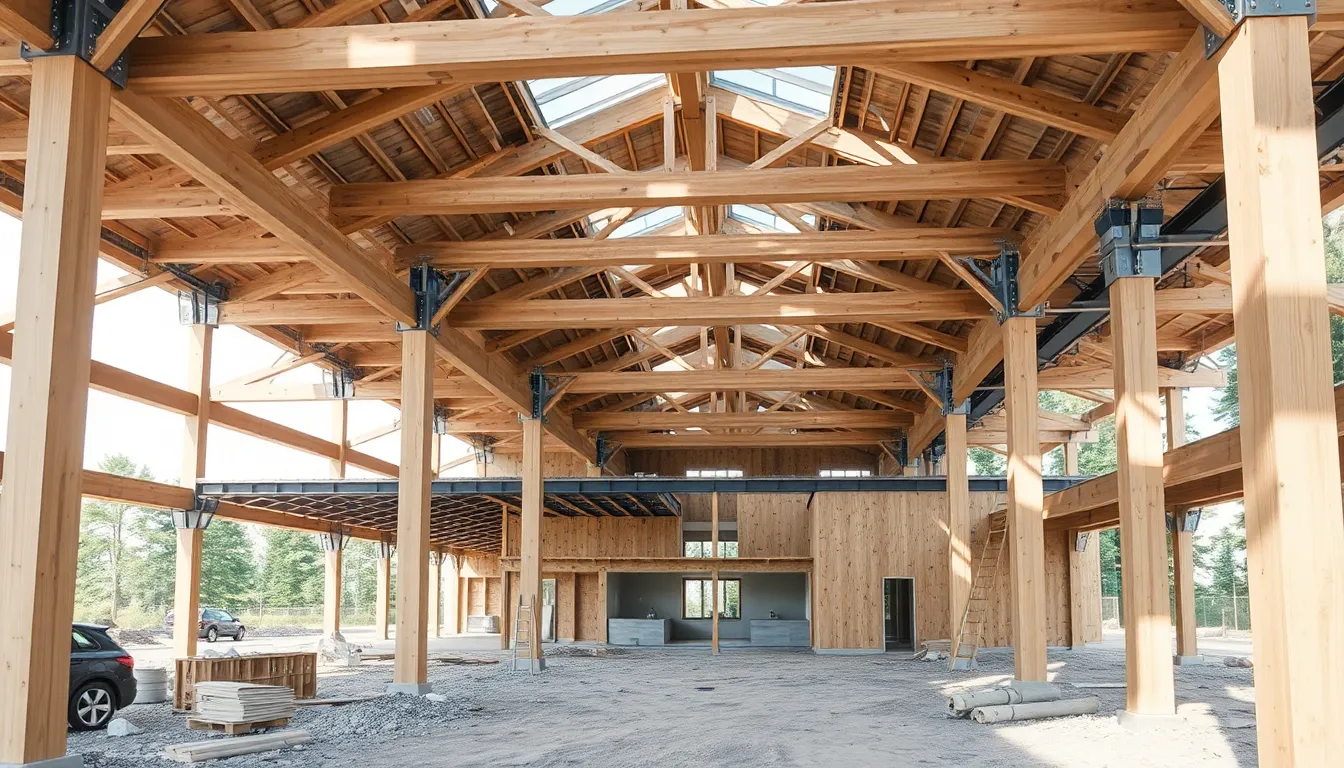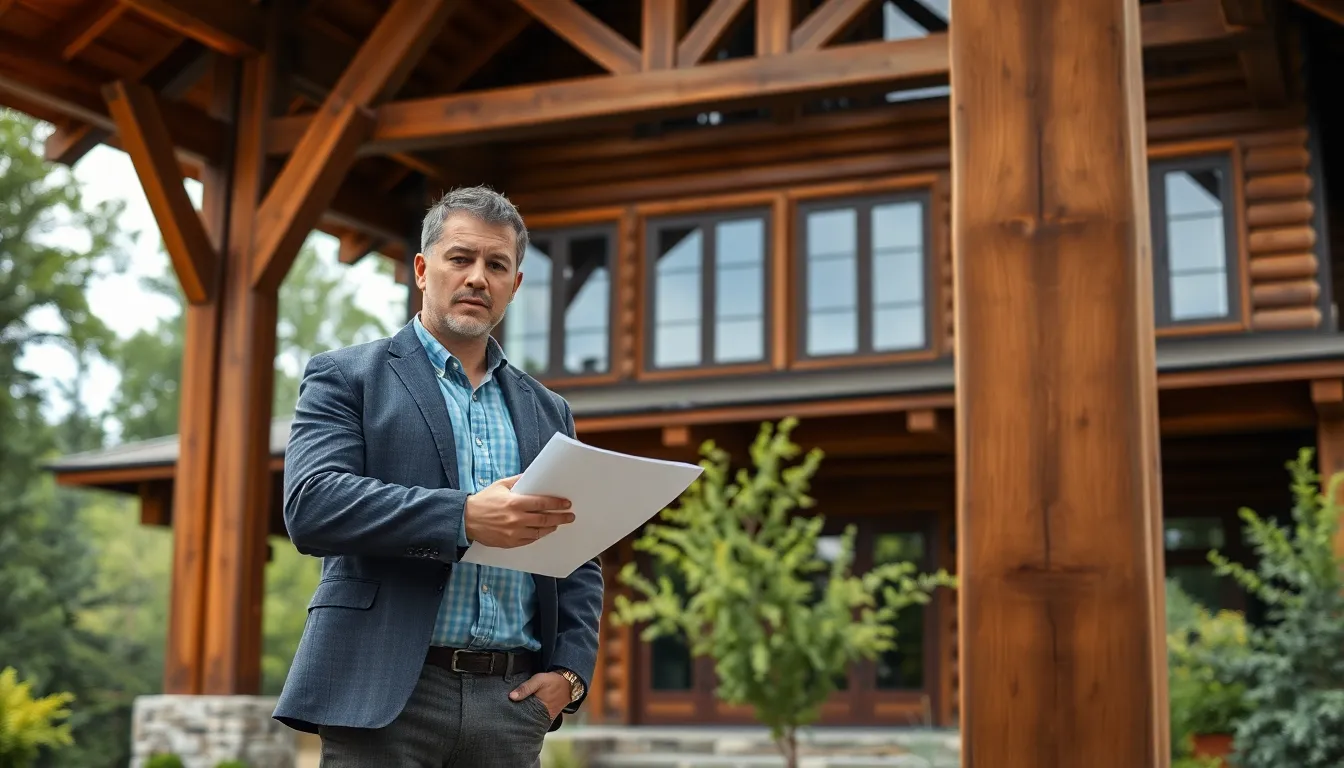Type 4 building construction, also known as “heavy timber” construction, is like the lumberjack of the architectural world—strong, sturdy, and surprisingly stylish. Imagine a structure that combines the charm of rustic wood with the resilience to stand the test of time. These buildings showcase the beauty of exposed timber while offering a solid foundation that can handle whatever Mother Nature throws their way.
But don’t let the term “heavy timber” fool you; it’s not just about heft. Type 4 construction is a smart choice for developers looking to balance aesthetics and safety. With the right design, these buildings can be both eye-catching and functional. So whether it’s a cozy cabin or a modern loft, understanding Type 4 construction can open the door to endless possibilities in the world of architecture. Let’s dive deeper into why this construction style is worth considering.
Table of Contents
ToggleOverview of Type 4 Building Construction
Type 4 building construction, often referred to as heavy timber construction, utilizes solid wood elements in its design. This method emphasizes the use of large timber frames, which enhance structural integrity. Builders value this approach for its robust nature, combining both strength and aesthetic appeal.
Timber contributes to a warm and inviting feel, making these structures popular in residential and commercial sectors. A variety of architectural styles can adapt Type 4 construction, including modern lofts, rustic cabins, and contemporary buildings. Safety remains a critical aspect, as the strong materials used in these constructions ensure resilience against environmental challenges.
Building codes across various regions recognize Type 4 construction for its fire resistance properties, which stem from the mass of the timber. This mass allows the wood to char without compromising structural stability. Fire safety measures further enhance the reliability of these structures when properly implemented.
In terms of sustainability, heavy timber construction promotes the use of renewable resources, aligning with modern environmental goals. Many developers are increasingly turning to Type 4 construction due to its combination of natural beauty and solid performance. Environments favoring speed in construction and lower maintenance costs often benefit from this method.
Type 4 construction integrates well with insulation technologies, leading to improved energy efficiency. Its appeal lies not only in its visual and functional benefits, but also in the economic advantages it presents for builders and developers alike.
Key Features of Type 4 Construction

Type 4 construction stands out due to its unique attributes and materials. It combines beauty and functionality, showcasing a range of essential features.
Materials Used
Large timber beams constitute the primary material in Type 4 construction. This heavy timber not only provides substantial structural support but also enhances aesthetic appeal. The use of wood contributes to a warmer interior atmosphere. Engineered wood products, such as glue-laminated timber, offer additional durability and flexibility. Complementary materials like metal connectors often assist in creating rigid frameworks. Natural resources are prioritized, aligning with sustainability trends in modern building practices.
Structural System
The structural system relies on large timber frames for strength and stability. Engaging post-and-beam configurations distribute loads efficiently throughout the building. This system allows for open interior spaces, encouraging flexibility in design. Cross-laminated timber or solid wood panels can enhance the overall integrity of the structures. The fire resistance of heavy timber plays a crucial role in safety, with charred wood maintaining strength during fires. Additionally, Type 4 buildings often exceed performance standards, appealing to both developers and occupants.
Benefits of Type 4 Building Construction
Type 4 building construction offers several advantages, making it a preferred choice for many developers and architects. Its unique characteristics align well with modern construction goals.
Cost-Effectiveness
Cost savings emerge as a significant benefit of Type 4 construction. Large timber frames and engineered wood products reduce material costs while enhancing durability. Labor expenses decrease due to the straightforward assembly process. Both residential and commercial projects experience reduced timelines, further minimizing costs. Developers can anticipate lower maintenance costs over time because of the robust nature of heavy timber structures.
Sustainability
Sustainability plays a vital role in Type 4 construction. This method utilizes renewable resources, reflecting environmentally responsible building practices. Heavy timber contributes to lower carbon footprints compared to conventional materials, promoting eco-friendliness. Energy efficiency improves through insulation technologies, leading to reduced utility bills. Furthermore, many species of timber used in these structures come from sustainably managed forests. The sustainable aspects of Type 4 buildings align with the growing demand for green construction solutions.
Challenges and Considerations
Type 4 construction presents challenges that require careful consideration. Understanding the unique attributes of this building style is essential for successful implementation.
Fire Safety Regulations
Navigating fire safety regulations poses a significant challenge for Type 4 construction. Heavy timber structures may seem more vulnerable, but the inherent fire resistance of thick wood plays a vital role. Building codes typically mandate specific fire ratings for materials. Consequently, compliance with these regulations is crucial for ensuring occupant safety. Fire safety measures may include the incorporation of sprinkler systems and fire-resistant barriers. Developers need to engage with local fire marshals and inspectors early in the design process to address these requirements effectively. This proactive approach not only enhances safety but also streamlines the permitting process.
Local Building Codes
Adhering to local building codes presents additional challenges for Type 4 construction. Building codes vary from region to region, influencing design choices and material selection. Many local regulations impose restrictions on height and occupancy limits for timber buildings. Understanding these stipulations ensures compliance and avoids costly redesigns. Engaging local authorities early can facilitate the design approval process. Additionally, addressing eco-friendly practices in line with sustainability goals may prove advantageous. As a result, early collaboration leads to smoother project execution while aligning with community standards.
Future Trends in Type 4 Construction
Increasingly, Type 4 construction embraces innovative technology to enhance design and efficiency. Developers now utilize advanced building information modeling (BIM) tools, allowing for precise planning and execution. As urban environments grow, architects are exploring mixed-use developments that incorporate Type 4 structures. This adaptability supports diverse usage while maintaining aesthetic integrity.
Sustainability practices continue to evolve within this construction style. Eco-friendly materials and techniques gain traction, emphasizing the use of renewable resources. Additionally, passive design strategies focus on natural ventilation and daylighting, reducing energy consumption further. Increased awareness of environmental impact pushes builders to consider lifecycle assessments across projects.
Collaboration among designers and engineers also shapes future trends. Integrated project delivery (IPD) methods promote teamwork to enhance communication and minimize costs. Combining engineering expertise with innovative design creates unique spaces that capture the spirit of Type 4 construction.
As energy efficiency demands grow, smart building technologies are coming to the forefront. Integrating energy management systems within these structures monitors and optimizes resource consumption. Installing renewable energy solutions, such as solar panels, showcases commitment to sustainability.
Fire safety remains paramount in Type 4 construction, prompting advancements in protective coatings and materials. Research and development in fire-resistant technologies contribute to enhanced occupant safety without compromising design. Regulatory compliance continues to influence the adoption of these innovations.
Engaging with community stakeholders during the planning process offers additional insights. This approach fosters a sense of ownership among residents and promotes social sustainability. Thoughtfully designed Type 4 buildings will meet modern demands for functionality while enhancing urban aesthetics.
Type 4 building construction stands out as a compelling option for those seeking a blend of durability and aesthetic appeal. Its heavy timber framework not only enhances structural integrity but also creates inviting spaces that resonate with warmth. As sustainability becomes increasingly vital in construction practices, Type 4’s use of renewable resources aligns perfectly with modern environmental goals.
With its cost-effectiveness and adaptability for various architectural designs, Type 4 construction is poised to meet the demands of both developers and occupants alike. Emphasizing fire safety and compliance with regulations ensures that these structures not only look good but also provide a secure living environment. The future of Type 4 construction looks promising as innovation continues to shape its evolution, making it a smart choice for contemporary building projects.






